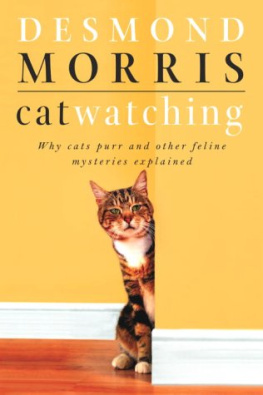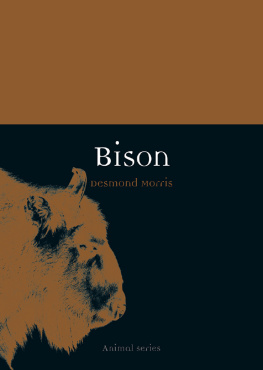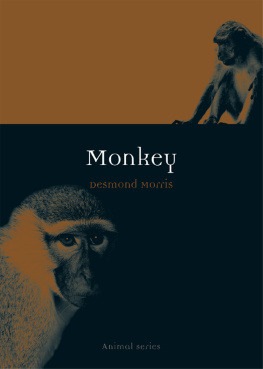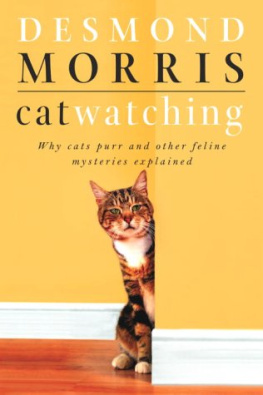Contents
About the Book
The personality of your cat is a fascinating mixture of affection and independence. You may think you know him as he purrs on your lap, but come across a cat on a dark night, amidst a soap-scene of sex and violence, and its easy to think he suffers from a dual personality.
However, each ear twitch and tail flick has a meaning. Every single cat carries an inheritance of amazing sensory capacities, vocal utterances, body language and territorial displays. By answering such questions as What does a cat signal with its ears? Why does your cat tear at the fabric of your chair? Why does a cat rub against your leg? Why does a cat hiss? Why does a cat swing its head from side to side when staring at its prey? Desmond Morris gives an extraordinary insight into the nature of your cat.
Also by Desmond Morris
The Biology of Art
Men and Snakes (co-author)
Men and Apes (co-author)
Men and Pandas (co-author)
The Mammals: A Guide to the Living Species
Primate Ethology (editor)
The Naked Ape
The Human Zoo
Patterns of Reproductive Behaviour
Intimate Behaviour
Manwatching
Gestures (co-author)
Animal Days
The Soccer Tribe
Inrock (fiction)
The Book of Ages
The Art of Ancient Cyprus
Bodywatching
The Illustrated Naked Ape
Dogwatching
The Secret Surrealist
Catlore
The Animals Roadshow
The Human Nestbuilders
Horsewatching
Animalwatching
Babywatching
Introduction
THE DOMESTIC CAT is a contradiction. No animal has developed such an intimate relationship with mankind, while at the same time demanding and getting such independence of movement and action. The dog may be mans best friend, but it is rarely allowed out on its own to wander from garden to garden or street to street. The obedient dog has to be taken for a walk. The headstrong cat walks alone.
The cat leads a double life. In the home it is an overgrown kitten gazing up at its human owners. Out on the tiles it is fully adult, its own boss, a free-living wild creature, alert and self-sufficient, its human protectors for the moment completely out of mind. This switch from tame pet to wild animal and then back again is fascinating to watch. Any cat-owner who has accidentally come across their pet cat out-of-doors, when it is deeply involved in some feline soap opera of sex and violence, will know what I mean. One instant the animal is totally wrapped up in an intense drama of courtship or status. Then out of the corner of its eye it spots its human owner watching the proceedings. There is a schizoid moment of double involvement, a hesitation, and the animal runs across, rubs against its owners leg and becomes the house-kitten once more.
The cat manages to remain a tame animal because of the sequence of its upbringing. By living both with other cats (its mother and litter-mates) and with humans (the family that has adopted it) during its infancy and kittenhood, it becomes attached to both and considers that it belongs to both species. It is like a child that grows up in a foreign country and as a consequence becomes bilingual. The cat becomes bi-mental. It may be a cat physically, but mentally it is both feline and human. Once it is fully adult, however, most of its responses are feline ones and it has only one major reaction to its human owners. It treats them as pseudo-parents. This is because they took over from the real mother at a sensitive stage of the kittens development and went on giving it milk, solid food and comfort as it grew up.
This is rather different from the kind of bond that develops between man and dog. The dog does see its human owners as pseudo-parents, like the cat. On that score the process of attachment is similar. But the dog has an additional link. Canine society is group-organized, feline society is not. Dogs live in packs with tightly controlled status relationships between the individuals. There are top dogs, middle dogs and bottom dogs, and under natural circumstances they move around together, keeping tabs on one another the whole time. So the adult pet dog sees its human family both as pseudo-parents and as the dominant members of its pack. Hence its renowned reputation for obedience and its celebrated capacity for loyalty. Cats do have a complex social organization, but they never hunt in packs. In the wild most of their day is spent in solitary stalking. Going for a walk with a human therefore has no appeal for them. And as for coming to heel and learning to sit and stay, they are simply not interested. Such manoeuvres have no meaning for them.
So the moment a cat manages to persuade a human being to open a door (that most hated of human inventions), it is off and away without a backward glance. As it crosses the threshold the cat becomes transformed. The kitten-of-man brain is switched off and the wild-cat brain is clicked on. The dog, in such a situation, may look back to see if its human pack-mate is following to join in the fun of exploring, but not the cat. The cats mind has floated off into another, totally feline world, where strange bipedal apes have no place.
Because of this difference between domestic cats and domestic dogs, cat-lovers tend to be rather different from dog-lovers. As a rule they have a stronger personality-bias towards independent thought and action. Artists like cats; soldiers like dogs. The much-lauded group loyalty phenomenon is alien to both cats and cat-lovers. If you are a company man, a member of the gang, one of the lads, or picked for the squad, the chances are that at home there is no cat curled up in front of the fire. The ambitious Yuppie, the aspiring politician, the professional footballer, these are not typical cat-owners. It is difficult to picture a rugger-player with a cat in his lap much easier to envisage him taking his dog for a walk.
Those who have studied cat-owners and dog-owners as two distinct groups report that there is also a gender-bias. Cat-lovers show a greater tendency to be female. This is not surprising in view of the division of labour that developed during human evolution. Prehistoric males became specialized as group hunters, while the females concentrated on food-gathering and child-rearing. This difference led to a human male pack mentality that is far less marked in females. Wolves, the wild ancestors of domestic dogs, also became pack-hunters, so the modern dog has much more in common with the human male than the human female. An anti-female commentator could refer to women and cats as lacking in team-spirit; an anti-male one to men and dogs as gangsters.
The argument will always go on feline self-sufficiency and individualism versus canine camaraderie and good-fellowship. But it is important to stress that in making a valid point I have caricatured the two positions. In reality there are many people who enjoy equally the company of both cats and dogs. And all of us, or nearly all of us, have both feline and canine elements in our personalities. We have moods when we want to be alone and thoughtful, and other times when we wish to be in the centre of a crowded, noisy room.
Both the cat and the dog are animals with which we humans have entered into a solemn contract. We made an unwritten, unspoken pact with their wild ancestors, offering food and drink and protection in exchange for the performance of certain duties. For dogs, the duties were complex, involving a whole range of hunting tasks, as well as guarding property, defending their owners against attack, destroying vermin, and acting as beasts of burden pulling our carts and sledges. In modern times an even greater range of duties has been given to the patient, long-suffering canine, including such diverse activities as guiding the blind, trapping criminals and running races.
Next page


















